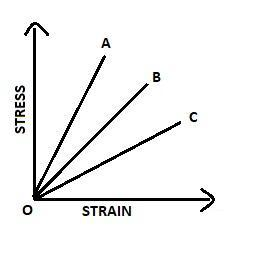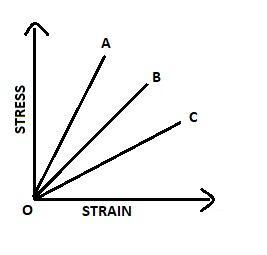
The stress-strain curves for brass, steel and rubber are shown in the figure. The lines A, B and C are for

(A) Rubber, brass and steel respectively
(B) Brass, steel and rubber respectively
(C) Steel, brass and rubber respectively
(D) Steel, rubber and brass respectively
Answer
218.7k+ views
Hint The slope of the stress-strain graph gives us the Young’s Modulus of elasticity . More the slope of the graph, more will be the value of Young’s Modulus of elasticity , more will be the elastic material .
Complete Step-by-step Solution
To identify which line belongs to which material , we will first learn about stress-strain diagrams in detail.
The graph that is given to us is –

The stress diagram can be drawn for any material. It tells us whether the substance is elastic or not. In simpler terms it tells us about the elasticity of any substance. The slope of different materials is different. Different materials can have very different values of slope. The ratio of stress to that of strain is called Young’s modulus. The slope of the graph gives us the value of Young’s modulus.
We are given three materials- steel, brass and rubber. Out of the three steel is the most elastic, rubber the least while the elasticity of brass lies in between the two.
Out of the three lines given in the curve. A has the maximum slope, C the minimum slope. And B in between . The Young’s Modulus for A is maximum making it the most elastic , C the least elastic and B in between.
We can draw the parallels in between the three-
A-maximum slope-most elastic-steel
B-moderate slope-medium elasticity- brass
C-minimum slope-least elastic-rubber
Hence, the correct option is C .
Note Young’s Modulus is a property of material. The area of the graph also helps us differentiate between brittle and ductile material.
Complete Step-by-step Solution
To identify which line belongs to which material , we will first learn about stress-strain diagrams in detail.
The graph that is given to us is –

The stress diagram can be drawn for any material. It tells us whether the substance is elastic or not. In simpler terms it tells us about the elasticity of any substance. The slope of different materials is different. Different materials can have very different values of slope. The ratio of stress to that of strain is called Young’s modulus. The slope of the graph gives us the value of Young’s modulus.
We are given three materials- steel, brass and rubber. Out of the three steel is the most elastic, rubber the least while the elasticity of brass lies in between the two.
Out of the three lines given in the curve. A has the maximum slope, C the minimum slope. And B in between . The Young’s Modulus for A is maximum making it the most elastic , C the least elastic and B in between.
We can draw the parallels in between the three-
A-maximum slope-most elastic-steel
B-moderate slope-medium elasticity- brass
C-minimum slope-least elastic-rubber
Hence, the correct option is C .
Note Young’s Modulus is a property of material. The area of the graph also helps us differentiate between brittle and ductile material.
Recently Updated Pages
Keplers second law is based on A Newtons first law class 11 physics JEE_Main

The P V diagram represents the thermodynamic cycle class 11 physics JEE_Main

A 5m long pole of 3kg mass is placed against a smooth class 11 physics JEE_Main

A uniform rod of 20 kg is hanging in a horizontal position class 11 physics JEE_Main

Derive an expression for maximum speed of a car on class 11 physics JEE_Main

Differentiate between audible and inaudible sounds class 11 physics JEE_Main

Trending doubts
JEE Main 2026: Application Form Open, Exam Dates, Syllabus, Eligibility & Question Papers

Derivation of Equation of Trajectory Explained for Students

Hybridisation in Chemistry – Concept, Types & Applications

Understanding the Angle of Deviation in a Prism

Understanding Collisions: Types and Examples for Students

Understanding Atomic Structure for Beginners

Other Pages
JEE Advanced Marks vs Ranks 2025: Understanding Category-wise Qualifying Marks and Previous Year Cut-offs

Units And Measurements Class 11 Physics Chapter 1 CBSE Notes - 2025-26

NCERT Solutions For Class 11 Physics Chapter 8 Mechanical Properties Of Solids

Motion in a Straight Line Class 11 Physics Chapter 2 CBSE Notes - 2025-26

NCERT Solutions for Class 11 Physics Chapter 7 Gravitation 2025-26

How to Convert a Galvanometer into an Ammeter or Voltmeter




